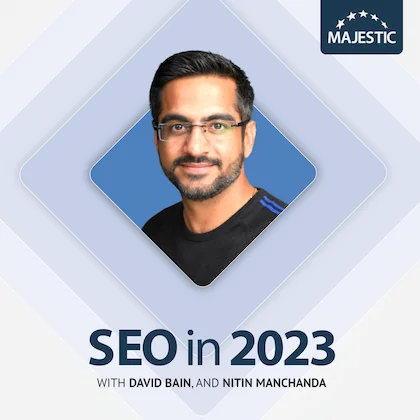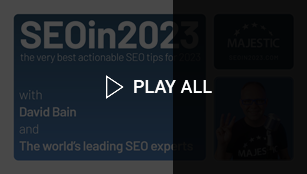-
Site Explorer
- Majestic
- Summary
- Ref Domains
- Backlinks
 New
New Lost
Lost- Context
- Anchor Text
- Pages
- Topics
- Link Graph
- Related Sites
- Advanced Tools
- Author ExplorerBeta
- Summary
- Similar Profiles
- Profile Backlinks
- Attributions
- Compare
-
Link Tools
- My Majestic
- Recent Activity
- Reports
- Campaigns
- Verified Domains
- OpenApps
- API Keys
- Keywords
- Keyword Generator
- Keyword Checker
- Search Explorer
- Link Tools
- Bulk Backlinks
- Neighbourhood Checker
- Submit URLs
- Experimental
- Index Merger
- Link Profile Fight
- Mutual Links
- Solo Links
- PDF Report
- Typo Domain
- Free SEO Tools
-
Support
- Blog

- Support
- Get started
- Tools
- Subscriptions & Billing
- FAQs
- Glossary
- How To Videos
- API Reference Guide

- Contact Us
- About Backlinks and SEO
- SEO in 2024
- Link Building Guides
- Webinars
- Blog
Matching demand with supply
Nitin Manchanda
Nitin Manchanda believes that SEO is a demand-based growth channel, and that through this way of thinking you can open yourself up to new opportunities and better target potential users in 2023.

Matching demand with supply
Nitin says: “It’s easy to miss out on important opportunities, but if you look at supply and demand parameters, you’ll position yourself to uncover new prospects.”
How do you establish what the demand is?
“Perform detailed keyword and competitive research to understand what people are searching for. You can then create clusters referred to as ‘demand parameters’.”
What are the most effective ways to establish which keywords you should be aiming for? How do you determine relevance and optimum keyword phrases to target?
“There are lots of parameters to consider in keyword research. Keyword difficulty is also important because it tells the story of how easy or difficult it is to crack a particular keyword. Keyword search volume is important because it tells you how many times a keyword is charged in a given month, geography, etc. It’s also worth looking at CPC, which will tell you if it’s a keyword that’s being targeted by brands. If so, that’ll mean there’s demand and you’ll have a great chance of converting.
There are some parameters you can look at to understand how important a keyword could be for a brand. Regarding relevance, you can look at the keywords and work out whether you have a good supply for them or not. For example, if you’re in an eCommerce company and you see a huge demand for ‘black dresses’ you don’t have the supply for, you’ll know not to go for that keyword. In this situation, if you were to create a landing page and generate traffic, you wouldn’t be able to fulfil commercial intent queries. Any rankings you’d get wouldn’t be sustainable and users wouldn’t convert.”
Which platform do you use to establish keyword difficulty?
“Semrush is a great tool because it’s reliable and easy to use.”
How do you work out if you’re likely to rank for difficult keywords?
“It depends on what kind of domain you’re working on. If it’s a fresh domain that doesn’t have strong authority, you should implement a strategy where you’re focusing on long-tails with less keyword difficulty. When you start gaining Google’s trust and begin ranking for these, you can gradually move on to more difficult keywords. Alternatively, if you’re working with a well-established eCommerce brand, they’ll be looking to create a ranking page and rank for it immediately. For example, established companies target super high-term keywords with massive search volume and high keyword difficulty. They’ll have a better chance to thrive because they already have amazing authority in their particular niche.
For a domain name or website that’s new, it’s important to consider whether you should publish content as a blog post, where it should go on your website, and whether or not it should be published at all. What also matters is the type of content you’re publishing. For example, if you’re expecting traffic where people are searching for ‘black dresses’, you should create a category page as opposed to a blog post. You can then put useful content there so you’re answering all the questions users might have. That’s how you should think about the quality of content for a specific page.”
How do you go about establishing a user’s intent?
“Semrush is a great tool for this because it will have data which is at least 70% reliable. You should also perform a manual check so you can understand whether the main keywords are important keywords. Avoid blindly trusting how a tool is putting a keyword into a category. The first step will resolve roughly 70% of your problem. Then you can do a quick scan to determine how keywords are mapped in terms of intent.”
How do you define and determine what to supply? What content should you create in order to satisfy the intent?
“Once you know your demand parameters, it’s very important to understand whether you have the right supply. You won’t want to generate traffic that doesn’t convert; traffic that leads to a high bounce rate but then the user never returns.
From the supply perspective, you’ll want to see if a user’s intent is informational. You’ll also want to determine if a user wants to buy or do something on the website. If you don’t provide that something for the user, then you won’t have that supply. It’s important to understand that when someone searches for ‘black dresses’ online, they won’t necessarily be looking for pages that just talk about ‘black dresses’. Even if your page was optimised for that particular URL and you started ranking, you wouldn’t be able to retain those rankings forever. You’d need black dresses in your inventory so that users could buy black dresses on your website.”
Are there any other buckets you can put people in regarding intent?
“The four intents are informational, commercial, navigational, and transactional. It’s easy to go through Semrush and assume you’ve covered everything, but there’ll always be more to consider than you realise.”
How would you define navigational intent?
“Navigational is mostly branded, where someone is looking for a particular brand and it’s clear they want to land on that brand’s website. For example, if you’re searching ‘Amazon’ on your iPhone X, that’s more navigational than commercial because it’s clear you want to go to Amazon.”
How do you define transactional?
“There is a good overlap. There’s a lot of confusion between transactional and commercial because transactional also looks at when the user wants to transact. There is a very thin line between commercial and transactional, so you can use either of the two. Transactional intent comes at the bottom of the funnel.”
What are the parameters that don’t matter?
“Many big companies over-optimise because they get behind something Google has said. However, this can be ill-advised. For example, let’s say you’re working for a company with a Core Web Vitals performance score of 90. They want to touch 100, so they rush to it because Google said it’s an important ranking factor. They get behind Google’s recommendations but then realise it’s a master task from an effort estimation perspective. It would be important to not purely focus on getting behind Google’s fancy numbers and instead focus on the user experience. If you think going from 90 to 100 would take a lot of time, you’d be better off spending that time on something built for users.”
What trends are you seeing in content types that are really effective at the moment?
“It depends on the kind of niche you’re in. For example, in eCommerce, video is trending a lot. Amazon Live is only available in the US but there are early-stage startups building similar products globally. Video is a hot trending concept in general. In the travel industry, people are more likely to gain inspiration from videos. They’ll want to see things like mountain ranges and get a visual overview that words can not describe.
It really depends on the type of content you’re producing and for which niche. Words can’t always do things justice. However, sometimes users will want to see images and read content too. Therefore, it’s important to embrace an integrated approach dependent on the situation at hand. For example, if someone wants to buy insurance they’ll probably just want to read an article about details or look directly at product pages and compare policies. Your content should be crafted around the niche you’re in.”
Are you seeing any particular trends with live video and the types of brands that are achieving success?
“It seems this concept is still in the development phase. There is another American brand called Whatnot.com that does something similar to Amazon Live. They’re successful as established players in the market with lots of categories. Users can search for things like category names followed by the term ‘video sale’ or something similar.
Their concept is rather new and is still developing. The brand is spending lots of money educating users that video sales are possible and that you don’t have to go to Amazon by default. Whatnot.com has product pages and category pages where you can look at products. They also provide opportunities to receive advice from experts on why you should buy something. They’re essentially using Amazon Live to drive customers off Amazon.”
Is demonstrating that SEOs need to be thinking outside the Google box an important metric or message?
“Yes. Even though you are an SEO, you should have a growth mindset. Think outside of the Google box because there’ll be lots of opportunities there. For example, if you’re working with a publisher, most of your traffic will come from Google news. This has a different set of parameters which aren’t really standard SEO.
Alternatively, you might work for another brand where 70% of traffic is coming from Discover. If so, you’d have to play a different SEO ballgame altogether. From a growth perspective, you should jump at every opportunity that can get traffic to you. SEO is not just SEO anymore, it’s evolved into much more than that.”
Nitin Manchanda is the Founder of botpresso and you can find him at botpresso.com.
Choose Your Own Learning Style
 Video
Video
If you like to get up-close with your favourite SEO experts, these one-to-one interviews might just be for you.
Watch all of our episodes, FREE, on our dedicated SEO in 2023 playlist.
 Podcast
Podcast
Maybe you are more of a listener than a watcher, or prefer to learn while you commute.
SEO in 2023 is available now via all the usual podcast platforms
Don't miss out
Opt-in to receive email updates.
It's the fastest way to find out more about SEO in 2025.
Could we improve this page for you? Please tell us





